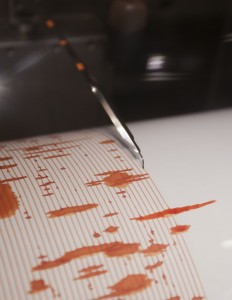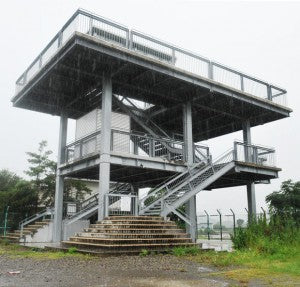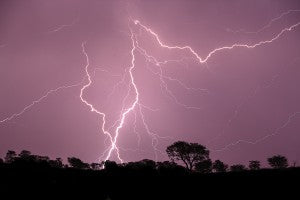Dark water surges from the sea, the 40 meter wave crashing down upon anything that stands in its way. Streets become rushing rivers, and then an extension of the ocean itself. Boats take to the flooded streets, belly up as they careen through the city. Entire buildings are uprooted from their foundation, tossed and battered as the tsunami waves push them farther and farther away from where they had once rested.
This may sound like something out of a fantasy novel (because really, a 40 meter wave?), but this is exactly what happened to Japan only four years ago. This video gives you just a taste of the destruction that took place:
[caption id="attachment_17837" align="alignright" width="300"]

How do you prepare for the unexpected?[/caption]
Four years ago, Japan was rocked by the Great East Japan Earthquake – a 9.0 magnitude – which was followed by a devastating tsunami. Now, the effected regions have had time to recoup and rebuild.
Japan is now teaching the world what it’s learned from this disaster.
Every 10 years, the United Nations holds a World Conference on Disaster Risk Reduction. This year it was hosted in Japan. In particular, the conference was held in Sendai, which, according to the
Japan Times, “is a city that is synonymous with resilience to disasters for its remarkable recovery from the Great East Japan Earthquake and tsunami.”
There are two things in particular that stand out from what Japan is trying to do.
- Cost effective prior investment
- “Building back better” (creating nations and regions that are more resilient than they were before the disaster)
Cost Effective Prior Investment
I think the key words here are “prior investment.” Following the Great East Japan Earthquake, the government took aims to make their nation safer when it comes to disasters.

This earthquake registered at 9.0 on the Richter scale, and when talking about it they use words like “unpredictable.” But guess what? It happened anyway, predictable or not. However, despite the unexpected quake, Japan already had preparations in place. Well, maybe not for a 9.0, but they get a 7.0 or 8.0 about once a decade, so earthquakes are something they have prepared for. That’s why they’re urging other nations to get prepared, just in case one of these “unpredictable” disasters strikes again. If something of this magnitude doesn’t strike, there are bound to be other disasters instead. As the saying goes, prepare for the worse, hope for a lesser disaster instead (or something to that effect).
Japan has also put into place a Disaster Prevention Law. Don’t be fooled, this law isn’t to meant to illegalize disasters (thereby reducing them through incarceration), but to Replace ways to make them less devastating. One way is through construction. Their high-rises sway like trees when the ground starts shaking. Because of their construction requirements, these buildings can withstand heavy quakes, thus saving countless lives within the buildings. Another way Japan prepares is by having homes and businesses stockpile food and water.
Sound familiar?
We talk all the time about storing food and water for those “unpredictable” moments. Fortunately for Japan, it was
before the disaster that these preventative measures were put into place. If they had waited until after this massive disaster, many more lives would have been lost. Of course, we’re talking about a global scale here, but we can definitely shrink it down to fit your personal life.
[caption id="attachment_17840" align="alignright" width="300"]

Do you know where you can go when disaster strikes?[/caption]
For example, how can “prior investment” relate to you? Well, in the same way the Japanese are gathering a supply of food and water for emergencies, can you do the same? Japan has also constructed tsunami evacuation towers to give people a place for refuge during such storms. Do you have your own personal evacuation tower? Where will you go when your tsunami crashes against you? Do you have preventative measures in place to weaken the blow, or lessen the damage?
Prior Investment now is the only way you will weather an earthquake, hurricane, accident, job loss, or any form of disaster that could affect you.
There are several ways to get started with your prior investment. Here are some pre-storm preparations to consider:
- Emergency kits
- First aid kits
- Food storage
- Water storage
- Contingency plan
There are many different kits available (pre-made) for your convenience, and at a good price. There are also plenty of individual kit items available, so you can build your own kits or add to existing ones (check out the links above for options and ideas).
There
is time to prepare before those “unexpected” disasters strike. That time is now.
“Building Back Better”
OK, so maybe you were caught off guard when disaster struck. What should you do now?
Well, I’ll tell you what you
shouldn’t do. You shouldn’t sit around thinking lightning doesn’t strike the same place twice. Just ask the folks in Kissimmee, Florida who had three hurricanes pass through in 2004, or the people in Moore Oklahoma, today digging out from their second tornado in less than 2 years. These are people committed to “Building Back Better.” We should be, too.

The odds of you getting struck by lightning twice is statistically very low, and the odds of you getting struck even once in your lifetime is 1 in 3000. So if it can happen once, it can happen again. Remember Japan’s 9.0 earthquake? The odds of an earthquake of that magnitude occurring was once in several
centuries. Who could have seen that one coming! But come it did. Just because the odds are in your favor, it doesn’t mean you’ll come out the victor.
When it comes to “building back better,” take a look at Japan’s example. They have become the leaders in helping countries be prepared for disaster.
There is a saying that goes, “Fool me once, shame on you. Fool me twice, shame on me.”
I’d like to change that up, if I could, to something a little more…human:
“Fool me once, shame on me for not preparing for it in the first place. Fool me twice…well, maybe I’ll get lucky? I hope.”
We should never let ourselves be fooled, not even once. It
shouldn’t happen, since we can all be prepared for anything. But being fooled twice is downright unacceptable. We need to learn from the past, be it our own or the past of others, like Japan. Lightning
has struck in the same place twice, after all (
or for one (un)lucky man, seven times).
We can learn a lot from The Great East Japan Earthquake. If you’re prepared before unforeseen disaster strikes, you will be so much better off. If you haven’t prepared…it’s time to take the next step and begin working on preparing yourself and your family.
Has disaster ever caught you unawares? What happened? Looking back, what could you have done better? Share with us your experiences!

 How do you prepare for the unexpected?[/caption]
Four years ago, Japan was rocked by the Great East Japan Earthquake – a 9.0 magnitude – which was followed by a devastating tsunami. Now, the effected regions have had time to recoup and rebuild. Japan is now teaching the world what it’s learned from this disaster.
Every 10 years, the United Nations holds a World Conference on Disaster Risk Reduction. This year it was hosted in Japan. In particular, the conference was held in Sendai, which, according to the Japan Times, “is a city that is synonymous with resilience to disasters for its remarkable recovery from the Great East Japan Earthquake and tsunami.”
There are two things in particular that stand out from what Japan is trying to do.
How do you prepare for the unexpected?[/caption]
Four years ago, Japan was rocked by the Great East Japan Earthquake – a 9.0 magnitude – which was followed by a devastating tsunami. Now, the effected regions have had time to recoup and rebuild. Japan is now teaching the world what it’s learned from this disaster.
Every 10 years, the United Nations holds a World Conference on Disaster Risk Reduction. This year it was hosted in Japan. In particular, the conference was held in Sendai, which, according to the Japan Times, “is a city that is synonymous with resilience to disasters for its remarkable recovery from the Great East Japan Earthquake and tsunami.”
There are two things in particular that stand out from what Japan is trying to do.
 This earthquake registered at 9.0 on the Richter scale, and when talking about it they use words like “unpredictable.” But guess what? It happened anyway, predictable or not. However, despite the unexpected quake, Japan already had preparations in place. Well, maybe not for a 9.0, but they get a 7.0 or 8.0 about once a decade, so earthquakes are something they have prepared for. That’s why they’re urging other nations to get prepared, just in case one of these “unpredictable” disasters strikes again. If something of this magnitude doesn’t strike, there are bound to be other disasters instead. As the saying goes, prepare for the worse, hope for a lesser disaster instead (or something to that effect).
Japan has also put into place a Disaster Prevention Law. Don’t be fooled, this law isn’t to meant to illegalize disasters (thereby reducing them through incarceration), but to Replace ways to make them less devastating. One way is through construction. Their high-rises sway like trees when the ground starts shaking. Because of their construction requirements, these buildings can withstand heavy quakes, thus saving countless lives within the buildings. Another way Japan prepares is by having homes and businesses stockpile food and water.
Sound familiar?
We talk all the time about storing food and water for those “unpredictable” moments. Fortunately for Japan, it was before the disaster that these preventative measures were put into place. If they had waited until after this massive disaster, many more lives would have been lost. Of course, we’re talking about a global scale here, but we can definitely shrink it down to fit your personal life.
[caption id="attachment_17840" align="alignright" width="300"]
This earthquake registered at 9.0 on the Richter scale, and when talking about it they use words like “unpredictable.” But guess what? It happened anyway, predictable or not. However, despite the unexpected quake, Japan already had preparations in place. Well, maybe not for a 9.0, but they get a 7.0 or 8.0 about once a decade, so earthquakes are something they have prepared for. That’s why they’re urging other nations to get prepared, just in case one of these “unpredictable” disasters strikes again. If something of this magnitude doesn’t strike, there are bound to be other disasters instead. As the saying goes, prepare for the worse, hope for a lesser disaster instead (or something to that effect).
Japan has also put into place a Disaster Prevention Law. Don’t be fooled, this law isn’t to meant to illegalize disasters (thereby reducing them through incarceration), but to Replace ways to make them less devastating. One way is through construction. Their high-rises sway like trees when the ground starts shaking. Because of their construction requirements, these buildings can withstand heavy quakes, thus saving countless lives within the buildings. Another way Japan prepares is by having homes and businesses stockpile food and water.
Sound familiar?
We talk all the time about storing food and water for those “unpredictable” moments. Fortunately for Japan, it was before the disaster that these preventative measures were put into place. If they had waited until after this massive disaster, many more lives would have been lost. Of course, we’re talking about a global scale here, but we can definitely shrink it down to fit your personal life.
[caption id="attachment_17840" align="alignright" width="300"] Do you know where you can go when disaster strikes?[/caption]
For example, how can “prior investment” relate to you? Well, in the same way the Japanese are gathering a supply of food and water for emergencies, can you do the same? Japan has also constructed tsunami evacuation towers to give people a place for refuge during such storms. Do you have your own personal evacuation tower? Where will you go when your tsunami crashes against you? Do you have preventative measures in place to weaken the blow, or lessen the damage?
Prior Investment now is the only way you will weather an earthquake, hurricane, accident, job loss, or any form of disaster that could affect you.
There are several ways to get started with your prior investment. Here are some pre-storm preparations to consider:
Do you know where you can go when disaster strikes?[/caption]
For example, how can “prior investment” relate to you? Well, in the same way the Japanese are gathering a supply of food and water for emergencies, can you do the same? Japan has also constructed tsunami evacuation towers to give people a place for refuge during such storms. Do you have your own personal evacuation tower? Where will you go when your tsunami crashes against you? Do you have preventative measures in place to weaken the blow, or lessen the damage?
Prior Investment now is the only way you will weather an earthquake, hurricane, accident, job loss, or any form of disaster that could affect you.
There are several ways to get started with your prior investment. Here are some pre-storm preparations to consider:
 The odds of you getting struck by lightning twice is statistically very low, and the odds of you getting struck even once in your lifetime is 1 in 3000. So if it can happen once, it can happen again. Remember Japan’s 9.0 earthquake? The odds of an earthquake of that magnitude occurring was once in several centuries. Who could have seen that one coming! But come it did. Just because the odds are in your favor, it doesn’t mean you’ll come out the victor.
When it comes to “building back better,” take a look at Japan’s example. They have become the leaders in helping countries be prepared for disaster.
There is a saying that goes, “Fool me once, shame on you. Fool me twice, shame on me.”
I’d like to change that up, if I could, to something a little more…human:
“Fool me once, shame on me for not preparing for it in the first place. Fool me twice…well, maybe I’ll get lucky? I hope.”
We should never let ourselves be fooled, not even once. It shouldn’t happen, since we can all be prepared for anything. But being fooled twice is downright unacceptable. We need to learn from the past, be it our own or the past of others, like Japan. Lightning has struck in the same place twice, after all (or for one (un)lucky man, seven times).
We can learn a lot from The Great East Japan Earthquake. If you’re prepared before unforeseen disaster strikes, you will be so much better off. If you haven’t prepared…it’s time to take the next step and begin working on preparing yourself and your family.
Has disaster ever caught you unawares? What happened? Looking back, what could you have done better? Share with us your experiences!
The odds of you getting struck by lightning twice is statistically very low, and the odds of you getting struck even once in your lifetime is 1 in 3000. So if it can happen once, it can happen again. Remember Japan’s 9.0 earthquake? The odds of an earthquake of that magnitude occurring was once in several centuries. Who could have seen that one coming! But come it did. Just because the odds are in your favor, it doesn’t mean you’ll come out the victor.
When it comes to “building back better,” take a look at Japan’s example. They have become the leaders in helping countries be prepared for disaster.
There is a saying that goes, “Fool me once, shame on you. Fool me twice, shame on me.”
I’d like to change that up, if I could, to something a little more…human:
“Fool me once, shame on me for not preparing for it in the first place. Fool me twice…well, maybe I’ll get lucky? I hope.”
We should never let ourselves be fooled, not even once. It shouldn’t happen, since we can all be prepared for anything. But being fooled twice is downright unacceptable. We need to learn from the past, be it our own or the past of others, like Japan. Lightning has struck in the same place twice, after all (or for one (un)lucky man, seven times).
We can learn a lot from The Great East Japan Earthquake. If you’re prepared before unforeseen disaster strikes, you will be so much better off. If you haven’t prepared…it’s time to take the next step and begin working on preparing yourself and your family.
Has disaster ever caught you unawares? What happened? Looking back, what could you have done better? Share with us your experiences!


